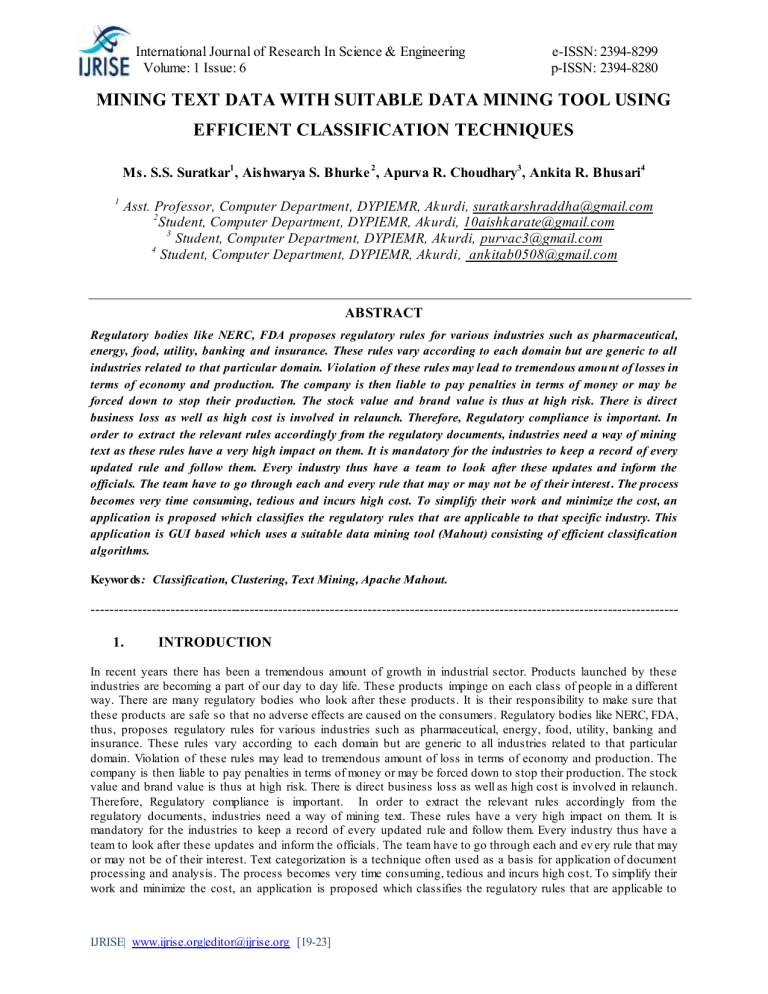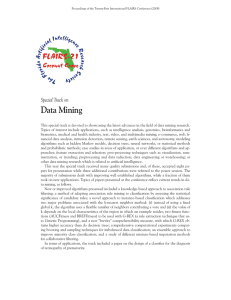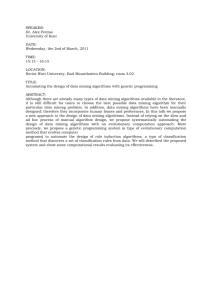Here

International Journal of Research In Science & Engineering
Volume: 1 Issue: 6 e-ISSN: 2394-8299 p-ISSN: 2394-8280
MINING TEXT DATA WITH SUITABLE DATA MINING TOOL USING
EFFICIENT CLASSIFICATION TECHNIQUES
Ms. S.S. Suratkar
1
, Aishwarya S. Bhurke
2
, Apurva R. Choudhary
3
, Ankita R. Bhusari
4
1
Asst. Professor, Computer Department, DYPIEMR, Akurdi, suratkarshraddha@gmail.com
2
Student, Computer Department, DYPIEMR, Akurdi, 10aishkarate@gmail.com
3
Student, Computer Department, DYPIEMR, Akurdi, purvac3@gmail.com
4
Student, Computer Department, DYPIEMR, Akurdi, ankitab0508@gmail.com
ABSTRACT
Regulatory bodies like NERC, FDA proposes regulatory rules for various industries such as pharmaceutical, energy, food, utility, banking and insurance. These rules vary according to each domain but are generic to all industries related to that particular domain. Violation of these rules may lead to tremendous amou nt of losses in terms of economy and production. The company is then liable to pay penalties in terms of money or may be forced down to stop their production. The stock value and brand value is thus at high risk. There is direct business loss as well as high cost is involved in relaunch. Therefore, Regulatory compliance is important. In order to extract the relevant rules accordingly from the regulatory documents, industries need a way of mining text as these rules have a very high impact on them. It is mandatory for the industries to keep a record of every updated rule and follow them. Every industry thus have a team to look after these updates and inform the officials. The team have to go through each and every rule that may or may not be of their interest . The process becomes very time consuming, tedious and incurs high cost. To simplify their work and minimize the cost, an application is proposed which classifies the regulatory rules that are applicable to that specific industry. This application is GUI based which uses a suitable data mining tool (Mahout) consisting of efficient classification algorithms.
Keywor ds : Classification, Clustering, Text Mining, Apache Mahout.
-----------------------------------------------------------------------------------------------------------------------------
1.
INTRODUCTION
In recent years there has been a tremendous amount of growth in industrial sector. Products launched by these industries are becoming a part of our day to day life. These products impinge on each class of people in a different way. There are many regulatory bodies who look after these products. It is their responsibility to make sure that these products are safe so that no adverse effects are caused on the consumers. Regulatory bodies like NERC, FDA, thus, proposes regulatory rules for various industries such as pharmaceutical, energy, food, utility, banking and insurance. These rules vary according to each domain but are generic to all industries related to that particular domain. Violation of these rules may lead to tremendous amount of loss in terms of economy and production. The company is then liable to pay penalties in terms of money or may be forced down to stop their production. The stock value and brand value is thus at high risk. There is direct business loss as well as high cost is involved in relaunch.
Therefore, Regulatory compliance is important. In order to extract the relevant rules accordingly from the regulatory documents, industries need a way of mining text. These rules have a very high impact on them. It is mandatory for the industries to keep a record of every updated rule and follow them. Every industry thus have a team to look after these updates and inform the officials. The team have to go through each and ev ery rule that may or may not be of their interest. Text categorization is a technique often used as a basis for application of document processing and analysis. The process becomes very time consuming, tedious and incurs high cost. To simplify their work and minimize the cost, an application is proposed which classifies the regulatory rules that are applicable to
IJRISE| www.ijrise.org|editor@ijrise.org
[19-23]
International Journal of Research In Science & Engineering
Volume: 1 Issue: 6 e-ISSN: 2394-8299 p-ISSN: 2394-8280 that specific industry. Automatic text categorization can be used based on the keywords reorganization. Thus the
GUI based can be designed which uses a suitable data mining tool (Mahout) consisting of efficient classification algorithm.
2.
LITERATURE SURVEY: A REVIEW
A comparative study of open source tools has been done as follows: [1]
Name of the tool
Desciption of the tool Advantages
RapidMiner
(formley known as
YALE)
WeKa
It is written in java. offers advanced analytics through template-based frameworks.
It provides functionality like data preprocessing and visualization, predictive analytics and statistical modelling, evaluation and deployment.
It is used for non-java version developed
-Offers numerous procedures, especially in the area of attribute selection and for outlier detection
R-
Programming for analysing data from the agricultural domain for java version tool is very sophisticated and used in many different applications including visualization and algorithms for data analysis and predictive modelling.
It is a software programming language and
-Suitable for developing new machine learning schemes.
-loads data file in formats of AREF,
CSV,C4.5,..
-Most comprehensive software environment for statistical computing and graphics. It is widely used among data miners for developing statistical software and data anaylsis.
Statistical analysis package available.
-No license restrictions ensuring our freedom to use it at our own.
Orange It is a python based ,powerful and open source tool for both novices and experts
Disadvantages
- Reason for this is software requires the ability to manipulate
SQL statements and files.
-Poor documentation, weak classical statistics, poor parameter optimization, weak csv reader.
-Documentation is sometimes patchy and terse.
-many Rcommands give a little thought to memory management.
-big installation,
Limited reporting capabilities
Apache mahout
It produces free implementations of distributed and otherwise scalable machine learning algorithms on the hadoop platform
-Better debugger,
Shortest scripts, poor statistics, suitable for novice Experts
-Aims to make building intelligent applications easier and faster.
-It is a scalable
Machine Learning
Implementation
-SQL-backed data stores don't work without the memory caching layer
Table-1 Tools used in data mining.
In the process of classification of text data Fig.1, we first collect different types of documents which are passed through pre-processing. Feature selection selects a subset of features from original documents. The selected features are then represented in a vector form and are classified according to supervised, unsupervised and semi-supervised method based on learning algorithm. [2]
IJRISE| www.ijrise.org|editor@ijrise.org
[19-23]
International Journal of Research In Science & Engineering
Volume: 1 Issue: 6 e-ISSN: 2394-8299 p-ISSN: 2394-8280
Fig-1: Document Classification Process
Types of classification models are Decision tree, Neural network and Generic algorithm. Types of clustering models are Hierarchical Methods, Partitioning Methods [3]. It is important to pre-process the text before clustering as mining from pre-processed text becomes easier as compared to natural language documents [4]. The standard filtering method is stop word filtering or stops words removal. Algorithms studied are k-means algorithm, kNN: knearest neighbour classification, Naive Bayes [5]. [6] is an e-book which explains why Mahout is the best tool for data mining. Mahout is an open source machine learning library from Apache. It has got an ability to deal with larger data sets. It requires resources that takes the computing time and memory less then input data. [7] Describes about feature selection:
Feature selection is a method of picking only selected attributes which are subset of the training set. It enables faster machine learning as the model becomes simpler and generalized. [8] Describes about preparing data inputs such as
Collecting the Data, Sparse Data, Attribute Types, Missing Values, Inaccurate Values and by Getting to Know Your
Data. [9] and [10] gives a brief about various clustering algorithms: Table.2 refers to complexities of clustering algorithms and their capability of handling high dimensional data.
C luste r
Algorithm
C omple xity C apability of tackling high dimensional data
K-means O(NKd)(time)
O(N+K)(space)
No
Fuzzy c-means
Near O(N) No
Hierarchical
Clustering
CLARA
BIRCH
O(N
O(N
2
)(time)
2
)(space)
O(K(40+K)
2
+K(N-K))
+
(time)
O(N)(time)
No
No
No
Table-2 Algorithm complexities.
3.
CHALLENGES
The feature vector or other structure which is used to indicate a document has complex semantics of natural language. The features must cover a wide range of class definitions. Most of the IE systems that involve semantic analysis exploit the simplest part of the whole spectrum of domain and task knowledge, that is, named entities.
IJRISE| www.ijrise.org|editor@ijrise.org
[19-23]
International Journal of Research In Science & Engineering
Volume: 1 Issue: 6 e-ISSN: 2394-8299 p-ISSN: 2394-8280
4.
PROPOSED FRAMEWORK
A classifier takes input from the uploaded text file containing the regulatory rules, which can be of any format
.doc, .txt, .pdf etc. It then classifies the text based on a predefined classifier model constructed with the help of training data set and displays the rules (Fig.2).
T raining Data Set
.docx
CLASSIFIER
[CLASS NAME]
Relevant set of rules
.txt
Data Mining Engine
[Apache Mahout]
Naïve Bayes Classification Algorithm
OUT PUT
INPUT
[T est Data]
Regulatory document
5.
PROPOSED ALGORITHM AND
Fig-2: Architecture
TOOLS
1.
Accept an input file.
2.
Classify the file based on pre-defined classes from the training data set.
3.
Display the classes which belongs to the file.
4.
The selected class details would be displayed.
6.
Name of the tool
Apache mahout
TOOL:
Description of the tool
It produces free implementations of distributed and otherwise scalable machine learning algorithms on the
Hadoop platform
Table-3: Tool used
Advantages
- Faster interaction with database
- Efficient use of algorithms
7.
CONCLUSION AND FUTURE WORK
Naïve Bayes is the best suited algorithm for text classification for medium data sets to large data sets. A Study of formulating the input for training data set is completed. Hadoop can be later on integrated in the same application
8.
REFERENCES
IJRISE| www.ijrise.org|editor@ijrise.org
[19-23]
International Journal of Research In Science & Engineering
Volume: 1 Issue: 6 e-ISSN: 2394-8299 p-ISSN: 2394-8280
[1] KalpanaRangra, Dr. K. L. Bansal,” Comparative
Study of Data Mining Tools”, IJARCSSE, Volume 4, Issue 6, June 2014 ISSN: 2277 128X
[2] Aurangzeb Khan, BaharumBaharudin, Lam Hong Lee*, Khairullahkhan, "A Review of Machine Learning
Algorithms for Text-Documents Classification", JOURNAL OF ADVANCES IN INFORMATION
TECHNOLOGY, VOL. 1, NO. 1, FEBRUARY 2010
[3] Bhumika, Prof Sukhjit Singh Sehra, Prof AnandNayyar, "A REVIEW PAPER ON ALGORITHM S USED
FOR TEXT CLASSIFICATION", International Journal of Application or Innovation in Engineering
& Management (IJAIEM) Web Site: www.ijaiem.org Email: editor@ijaiem.org, editorijaiem@gmail.com
,
Volume 2, Issue 3, March 2013 ISSN 2319 – 4847
[4] Greeshma RG, Smitha ES "A review on mining text data with auxiliary attributes", July 2015, Volume 2,
Issue 6 JETIR (ISSN-2349-5162)
[5] Xindong Wu · Vipin Kumar · J. Ross Quinlan · Joydeep Ghosh · Qiang Yang · Hiroshi Motoda · Geoffrey
J. McLachlan · Angus Ng · Bing Liu · Philip S. Yu · Zhi-Hua Zhou · Michael Steinbach · David J. Hand ·
Dan Steinberg, "Top 10 algorithms in data mining", KnowlInfSyst (2008) 14:1–37 DOI 10.1007/s10115-
007-0114-2 SURVEY PAPER, Received: 9 July 2007 / Revised: 28 September 2007 / Accepted: 8 October
2007 Published online: 4 December 2007 © Springer-Verlag London Limited 2007
[6] Sean Owen, Robin Anil, Ted Dunning, Ellen Friedman, "Mahout in Action", ©2012 by Manning
Publications Co., www.manning.com.
[7] Christopher D. Manning, Prabhakar Raghavan & Hinrich Schütze, "Introduction to Information Retrieval"
", ©2013.
[8] Ian H. Witten ,Eibe Frank , Mark A. Hall ," DATA MINING practical Machine Learning Tools and
Techniques ( 3rd edition) "
[9] Rui Xu and Donald Wunsch II, "Survey of Clustering Algorithms", IEEE TRANSACTIONS ON
NEURAL NETWORKS, VOL. 16, NO. 3, MAY 2005 645
[10] S. Revathi, Dr.T.Nalini, "Performance Comparison of Various Clustering Algorithm", International Journal of Advanced Research in Computer Science and Software Engineering Research Paper
Available online at: www.ijarcsse.com , Volume 3, Issue 2, February 2013 ISSN: 2277 128X
IJRISE| www.ijrise.org|editor@ijrise.org
[19-23]





